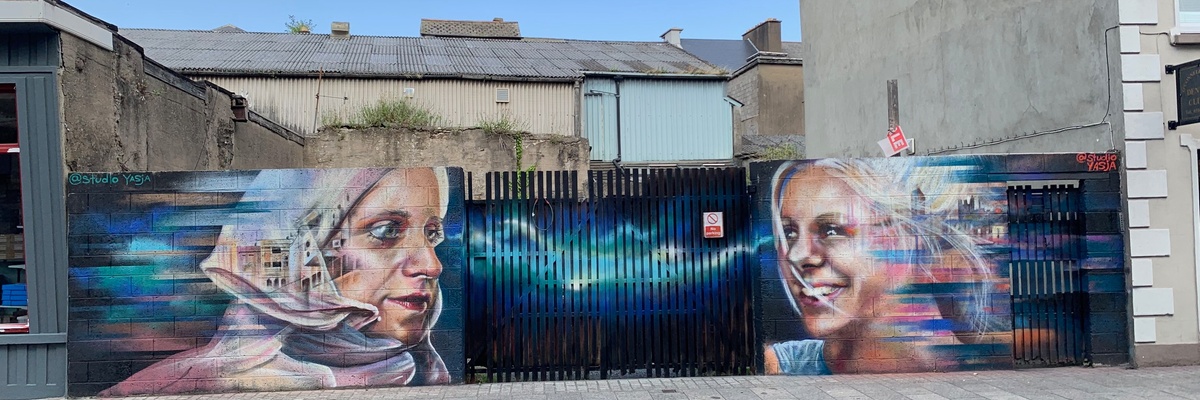
"Connecting people with fun & creativity through Murals for Communities brings joy to the places that we live, work and play. It's amazing to see all ages and abilities coming together through public art, especially when murals are created in forgotten spaces." - Katherine Collins, Murals for Communities Project Lead, Waterford

Organising a mural in your community takes some time including getting permissions to put up a mural from your local planning authority (up to 8 weeks), plus time for the artist to work with the community to develop the idea (4 weeks).
Decide if this is a long or short term project and who the project is for.
Community members of all ages and abilities will benefit from being actively involved in the project and the more engaged they are from the get go the more invested they will be in the process and end result. It's also important to remember that as well planning a series of workshops for children, adults, seniors, families, neighbours etc. through which themes such as integration, play, climate, health, friendship etc. can be discussed it's also important to have fun! Your Mural Project can be as simple or as detailed as you like and the more engaged your project team are from the start the greater the sense of ownership there will be.
Think about working with children to bring their playful creativity to an unloved local area or a much loved play space so they can experience the magic of having their thoughts, feelings and imaginations turned into a piece of public art.
It's really important to consider whether you are considering this project from a short or long term perspective. We would very much advocate the latter and encourage you and your group to look at mural art from a broader perspective and as an important, integrated part of any society in the 21st century. This decision will help you work out the who, where and why of the Mural Art project - always remembering it's about community, connection and collaboration as much as it is the visual transformation of your local area.
Here are some questions as you set goals & objectives for your project:
There's a bit to consider as your map out your project and assembling your team is a big part of it. Mural Routes, a Canadian organisation working with communities to create murals and public art projects have kindly offered the use of their Murals for Communities Handbook - a brilliant resource that we highly recommend you check out and follow!
You are going to meet a lot of people - all of whom have a really important role to play in this project! You'll need an artist to help with the design and facilitation of the project, a contact in your local Town/City Council for permissions, connections and funding, other community representatives - especially those from the immediate area for which the project is planned as their thoughts and opinions matter and local media to tell your story and share the impact you want this project to have.
If your project is child-centric you'll need a facilitator experienced in engaging children and young peole throughout the process to ensure the workshops, design, mural creation and celebration of same are inclusive of them. It's important the activies are playful as well as educational and children's opinions and voices are considered.
This is the Pre-Production phase and you'll need to consider the following:
Plan the Workshops and Start the Design Process
This is a really important stage of the process for which you'll need a suitable venue etc. and below are some questions to consider and actions to take - most of which will be led by the Project Facilitator and Artist members of your team:
Workshops & Designs
At the end of this step you'll have a detailed action plan so can start putting some dates in place for the workshops etc. - always allow for a Plan B in case you're preferred 'canvas' is no longer available or the weather changes timelines!
Make it Happen
Follow the plan - and be prepared to adjust as you go! Let your wider team know about the workshops and support your Facilitator to ensure everything you need for the workshops is there - e.g. presentation paper, whiteboards, pens, post-its, etc. to capture all the great ideas, suggestions, designs, and concerns of the project team. The facilitator will apply proven workshop methodology to ensure all voices are heard and progress is made and you will delegate key tasks and set up communication channels so that everyone stays informed and engaged.
Celebrate and Evaluate
Together you've created something worth celebrating! It's always a great idea to bring everyone together for a 'launch' of the mural art - and if you have permission and budget to create an event with food, music and the like then do. This is also a great time to gather feedback from everyone involved and you can use questionnaires with a follow up online survey tool etc. to collect all important data. People can provide feedback in a multitude of ways including written questionnaires, verbal recordings, pieces to camera etc. If children are part of the project ensure you have completed all consent forms re the taking and sharing of photos, videos etc.
Consider how best to evaluate your project, asking community, artists and funders about their reaction to both the process and the final art work as well as impact on the area and on the participants. This information will be used to support other funding proposals as well as local community development plans so is really worth doing.
Feedback to consider:
And last but not least continue to celebrate and publicise your project - you have an incredible piece of art and a great story to share that may well inspire others so spread the word!